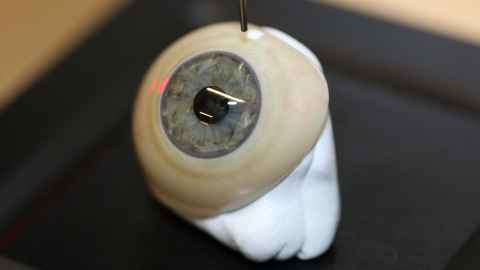Successful partnership aims to improve experience for prosthetic eye wearers
14 February 2019
Our expertise offered a possible new solution for a problem Dr Keith Pine had been researching.

A partnership between Dr Karnika De Silva of the NZ Product Accelerator and Department of Chemical and Materials Engineering, and Dr Keith Pine from NZ Prosthetic Eye Service is the first step on a journey that could result in some major benefits for people who wear prosthetic eyes made from polymethyl methacrylate (PMMA).
“Modern prosthetic eyes look good and are well-tolerated,” Dr Pine explains. “But if you ask prosthetic eye wearers what their biggest concerns are, it turns out that it’s the mucoid discharge that is generated in the socket as a response to prosthetic eye wear.”
Mucoid discharge is a normal response to irritation such as when eyelids are blinking over the dry surfaces of PMMA eyes which are very hydrophobic. Dr Pine had tested some hydrophilic coatings but these materials were dangerous to use and impractical to apply in a clinical setting. He had tried different surface polishes, such as an optical grade contact lense polish, and found these could make the surface of the PMMA prosthetic more hydrophilic - and therefore less irritable. But these highly polished PMMA eyes were still not as comfortable to wear as glass eyes which are still used in German-speaking countries but with their own share of downsides.
The goal then was to create a prosthetic eye that preserved the positive traits of PMMA, but which caused less irritation for the person wearing it. Dr Pine had set one of his colleagues the task of borrowing some equipment from the University. She ended up coming back with the recommendation that Dr Pine should get in touch with the NZ Product Accelerator programme to see what solutions they might offer.
“NZ Product Accelerator is a national programme, so we have eight universities and three CRIs participating and collaborating with us,” Dr De Silva said. “When Dr Pine approached us, we organised a meeting with the group and they came up with different ideas, like 3D printing and putting coatings on, and I made the suggestion that we should go deep into the polymer and modify the polymer itself.”
“You have you just made my day”, Dr Pine responded. “The suggestion was music to me, because we weren't talking about coatings or polishes anymore, we were talking about altering the polymer, the actual material itself. So that was worth pursuing.”
The project is defined as a safe starting point. What Drs Pine and De Silva know is that they have a material that is as workable as PMMA, but more hydrophilic - and therefore less irritable - than the PMMA currently used for prosthetic eyes. The next steps involve completing in vivo testing to measure the behaviour of tears and provide a comparison between the two materials in terms of wearing comfort and long-term socket damage. An application has recently been submitted to the UoA Human Participants Ethics Committee for this.